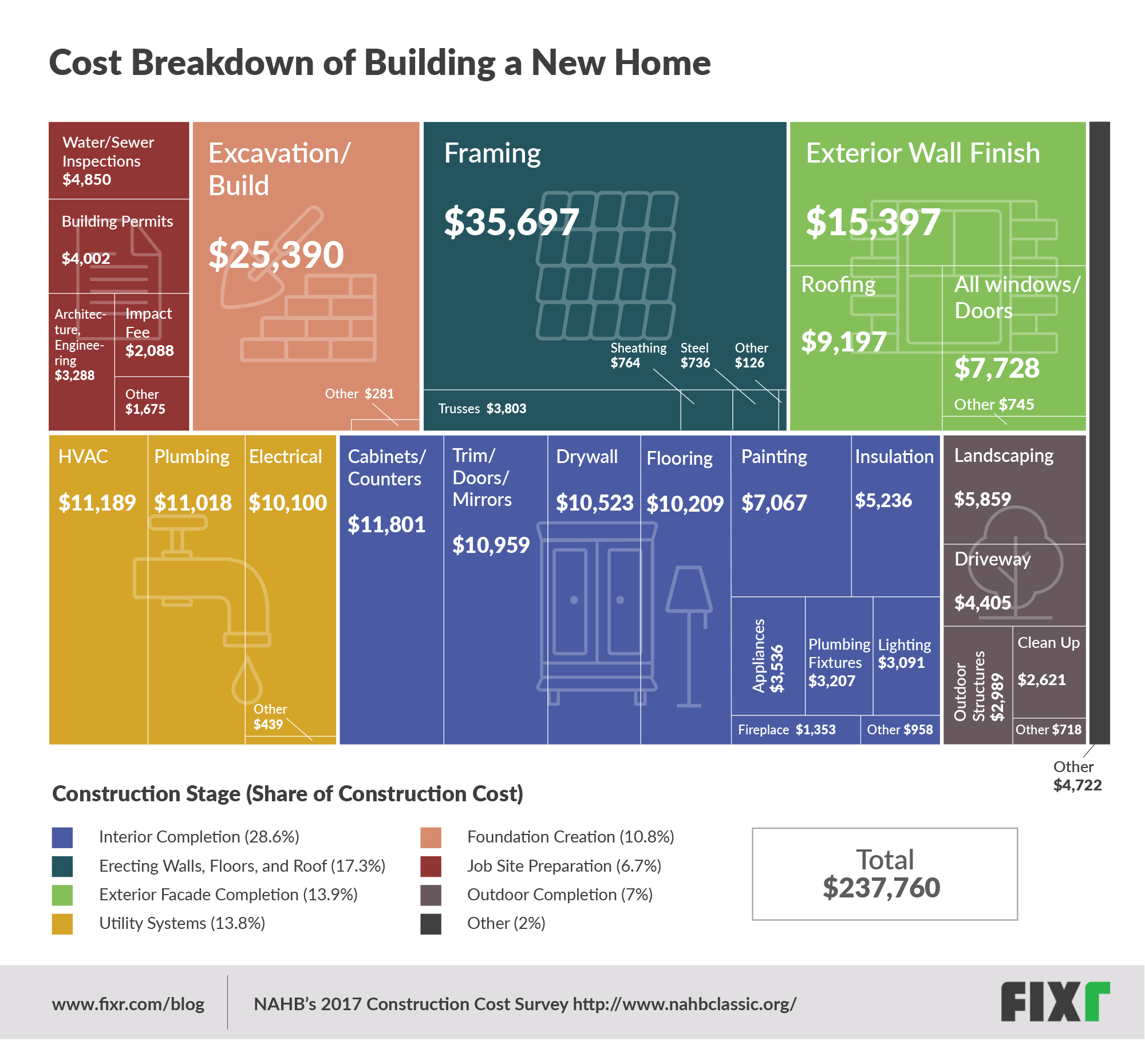A new home is always considered a milestone in life, especially if it's your first, whether you are buying an existing place or building from scratch. Here, we look at the price tag on building your own home, which has the benefit of everything being shiny and new, right where you want it, with better green ratings and better efficiency. We break down the costs involved and help you to get a better idea of how the lump sum is divided, so you can plan for possible savings, and have a better understanding when your contractor starts talking shop, especially if this is your first build.
A graphic breakdown of the construction costs

The graphic above is based on data taken from the NAHB's construction cost survey, conducted in 2017. The survey is based on the responses from 4,267 home builders and the costs indicated are for a single-family home, with a lot size of 11,186 square feet and an average finished area of 2,776 square feet. The costs include costs to the builder including labor, cost of materials and charges by subcontractors.
We broke the overall cost of $237,760 down into eight main stages of construction, which are represented graphically, with the initial stages at the top left, moving in order of construction down to the final touches at the bottom right. The stages are: Job Site Preparation, Foundation Creation, Erecting Walls, Floors and Roof, Exterior Facade Completion, Utility Systems, Interior Completion, Outdoor Completion, Other. Each section has been broken down into the various related tasks, with a total of 36 subcategories. The most expensive stage was Interior finishes, which includes appliances and fittings, which came in at $67,390, followed by Erecting walls floor and roof at $41,123, Exterior facade completion at $33,066, Utility systems at $32,746, Foundation creation at $25,671, Outdoor completion including landscaping at $16,591 and site work as the lowest specific stage at $15,903, with an extra $4,722 allocated to Other expenses.
The total fee of $237,760 only accounts for the build fees and assumes the purchase price, including taxes and commissions, is a separate, additional fee. This allowed us to view the project as a whole with a standard starting point of a cleared, owned site, to avoid too many variables affecting the outcome.
Wise choices help your bottom line
It is always important to keep in mind the potential variables across the board, with regard to local pricing, material availability, labor availability and timing factors. However, this graphic gives some important insight into expenditure allocations and what that means to the homeowner that chooses to build.
Highest item costs
Breaking down costs help establish where savings can be made, and where the most investment should be focused. A saving on the individual items that cost the most can be most beneficial to your bottom line; a saving of 10 % on an item that accounts for 10% of the build is a saving of $4,755, compared to a 10% saving on an item that only accounts for 1% of the build ($475). In this instance Framing and trussing, have the highest individual cost, with 16.6% of the total. The next highest, Foundations, comes in at 10.8% of the total. At the other end of the scale, the items that make up the lower percentages of the overall cost are often variables like lighting and outdoor structures that are variable and even if you make cost-wise choices, won't affect the bottom line much.
Materials and finishes need careful consideration
Interior completion, which includes materials and finishes, is another area in which savings can be made. Considering interiors account for 28.6% of total cost, deciding to put in laminate instead of hardwood flooring, or choosing a standard refrigerator versus a custom design, could save thousands of dollars. Then again, it can be beneficial to spend more now to save in the future. Ensuring your house is built to maximise efficiency and installing modern appliances with Green Star ratings can be a worthwhile investment to cut costs considerably in the long run.
Dictated costs
Finally, there are areas where you don't have much control, for instance, Job site preparation includes assessment and inspection fees which are set state or municipal rates, and account for 4.6% of the total cost in 2017. These rates have been increasing, they were up from 3.2% in 2015, and 61% of builders claim these fees are a significant challenge.
What these costs mean to you, a potential home builder
According to a recent study, 41% of Americans polled, stated they would prefer a newly built home compared to only 21% who would prefer existing homes. The challenge with this is that building a new home comes with a median price tag approximately 33% higher than the median cost of buying an existing home, which many are unable to pay. However, the study also mentions that new homes are generally larger from a square foot perspective, so the per meter cost is actually about 30% lower than a home built before the 1960s. The higher cost is still there, but homeowners are getting more square footage for their buck.
Given all of the data above, the most important step to take, before deciding whether you are going to build or not, is to create your own list of priorities. For some a custom designed floor plan outweighs the benefits of living in your preferred neighbourhood. For others, the time investment required to build is far too high, so buying an existing home is the obvious solution. Your priorities will dictate your final decision. This cost breakdown can help that decision be an informed one.